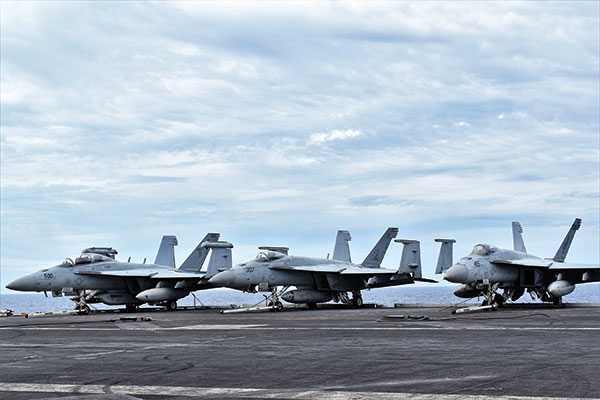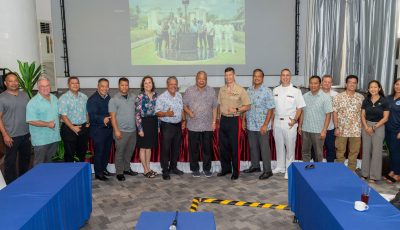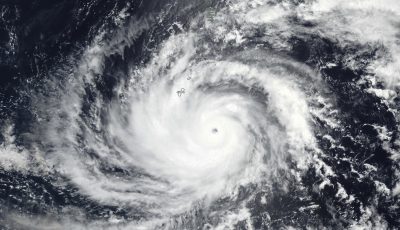‘Marianas waters excellent place for training’

F/A 18 Hornet fighter jets rest at the flight deck after their daiky exercise last Wednesday at the USS Ronald Reagan supercarrier. (Jon Perez)
USS RONALD REAGAN—Rear Adm. Karl Thomas said they usually move around the Western Pacific Theater near the waters of the Marianas, as the area is an excellent place to hold joint trainings with U.S. military forces.
Thomas heads the U.S. Navy’s largest battle group that has the USS Ronald Reagan (CVN 76) as its flagship. The Combined Task Force 70 and Carrier Strike Group 5 are homeported at the Yokosuka Naval Base in Japan.
“We move around the Western Pacific Theater and we also go around to other theaters. But having a fully deployed Naval force allows us to get to places quickly. We like coming here to Guam, Saipan, Tinian, and Rota,” Thomas told members of the media who had the chance to go aboard the Nimitz-class nuclear-powered super carrier on Wednesday.
A theater, in warfare, is an area where military exercises occur including airspace, and land and sea areas that have the potential of being involved in future war operations.
Thomas said the waters in the Marianas are an excellent space for training. “It is great for these types of operation that we do, that require hundreds of miles of space. It has a lot of airspace and a great place to do training. We can have joint training exercises with the Army, Air Force, and Marine Corps. Plus, the sailors like the ports here. They enjoy Saipan and Guam.”
He added that they just finished with Exercise Valiant Shield, a U.S.-only exercise they conduct with the Army, Marine Corps, Air Force, and the Navy. “You can imagine getting all these capabilities together and working together as a team. It takes practice. So when we bring all of them into this area, some play the bad guys and some the good team. We play against each other [and] experience tactics and techniques that increase our capabilities.”
Aside from the USS Ronald Reagan, more than 100 different types of aircraft—used for war games, search and rescue operations, and relief—cruisers, and destroyers are also under the carrier strike group.
The carrier strike group always practices for expected and unexpected scenarios. “This…is to provide options to our national leadership, to allow us to help other nations, and to enforce the laws of the sea. This is a very versatile group of ships and aircraft that go where we are needed.”
Half the year, the more than 5,000 officers and crew of the strike group spend their time at sea. “Half the year we are at port but we tend to break it up and move it a little bit. We try to be unpredictable. We go where we are needed and we spent quite some time at sea. That’s what we are needed to do.”
Thomas said his strike group was also at the coast of Rota and Tinian when Typhoon Mangkhut hit the CNMI. “It was the [USS] Wasp that was a lot closer to them. The Wasp was capable of helping those islands but we also provided some of our helicopters.”



























